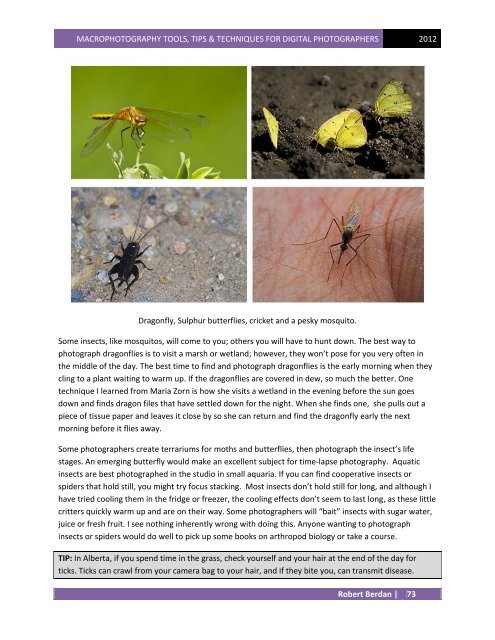Download PDF - The Canadian Nature Photographer
Download PDF - The Canadian Nature Photographer
Download PDF - The Canadian Nature Photographer
Create successful ePaper yourself
Turn your PDF publications into a flip-book with our unique Google optimized e-Paper software.
MACROPHOTOGRAPHY TOOLS, TIPS & TECHNIQUES FOR DIGITAL PHOTOGRAPHERS 2012<br />
Dragonfly, Sulphur butterflies, cricket and a pesky mosquito.<br />
Some insects, like mosquitos, will come to you; others you will have to hunt down. <strong>The</strong> best way to<br />
photograph dragonflies is to visit a marsh or wetland; however, they won’t pose for you very often in<br />
the middle of the day. <strong>The</strong> best time to find and photograph dragonflies is the early morning when they<br />
cling to a plant waiting to warm up. If the dragonflies are covered in dew, so much the better. One<br />
technique I learned from Maria Zorn is how she visits a wetland in the evening before the sun goes<br />
down and finds dragon files that have settled down for the night. When she finds one, she pulls out a<br />
piece of tissue paper and leaves it close by so she can return and find the dragonfly early the next<br />
morning before it flies away.<br />
Some photographers create terrariums for moths and butterflies, then photograph the insect’s life<br />
stages. An emerging butterfly would make an excellent subject for time-lapse photography. Aquatic<br />
insects are best photographed in the studio in small aquaria. If you can find cooperative insects or<br />
spiders that hold still, you might try focus stacking. Most insects don’t hold still for long, and although I<br />
have tried cooling them in the fridge or freezer, the cooling effects don’t seem to last long, as these little<br />
critters quickly warm up and are on their way. Some photographers will “bait” insects with sugar water,<br />
juice or fresh fruit. I see nothing inherently wrong with doing this. Anyone wanting to photograph<br />
insects or spiders would do well to pick up some books on arthropod biology or take a course.<br />
TIP: In Alberta, if you spend time in the grass, check yourself and your hair at the end of the day for<br />
ticks. Ticks can crawl from your camera bag to your hair, and if they bite you, can transmit disease.<br />
Robert Berdan | 73




